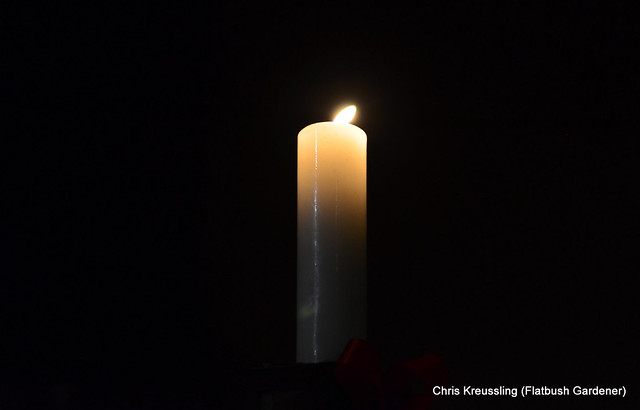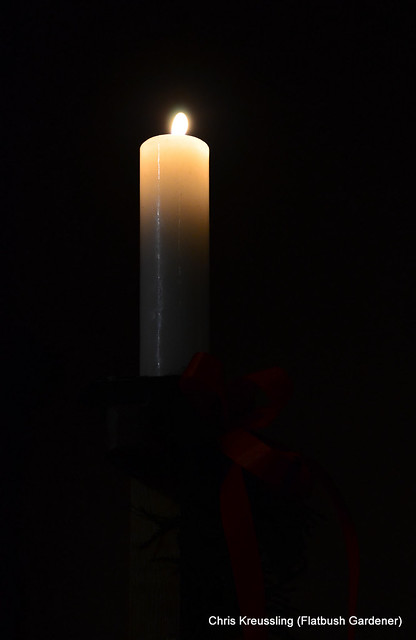
The Anthropocene weighs heavy on my mind, and heart:

The name is derived from the Latin sol (sun) and sistere (to stand still), because at the solstices, the Sun stands still in declination; that is, its apparent movement north or south comes to a standstill.This year feels darker than most. Yesterday, as expected, the U.S. presidential electorate election was affirmed. "Standing Still" takes on a different meaning if there's a chance the light won't return.
- Solstice, Wikipedia

You can blow out a candleWishing for peace, wishing you peace, these dark days.
But you can't blow out a fire.
Once the flames begin to catch
The wind will blow it higher.

The name is derived from the Latin sol (sun) and sistere (to stand still), because at the solstices, the Sun stands still in declination; that is, its apparent movement north or south comes to a standstill.We've had no clear winter here in NYC. It finally got "cold" over the weekend, with temperatures threatening frost, but not quite making. So far, Central Park has had the 3rd longest run of frost-free days in history, and we are within reach of breaking the record.
- Solstice, Wikipedia
The name is derived from the Latin sol (sun) and sistere (to stand still), because at the solstices, the Sun stands still in declination; that is, its apparent movement north or south comes to a standstill.It's clearly winter here. The past few days the high temperature has hovered around freezing, and skies have been overcast. Gray, cold days. There seems to be little light in the world at large, these days. Sometimes it's enough to just hold out for warmer, greener days.
- Solstice, Wikipedia

The name is derived from the Latin sol (sun) and sistere (to stand still), because at the solstices, the Sun stands still in declination; that is, its apparent movement north or south comes to a standstill.This year's Winter Solstice is remarkable for an unusual astronomical coincidence: The lunar eclipse occurring later tonight, early tomorrow morning. I've seen a range of reports on the last time this occurred, from 372 to 645 years. According to Wikipedia, the last time this occurred was in 1638. Whatever, it's in centuries, so rare enough for my lifetime.
- Solstice, Wikipedia
In the New York area, the eclipse will officially begin on December 21 at 12:29 am as the Moon begins to enter Earth’s outer, or penumbral, shadow. But even in clear weather sky watchers will not notice any changes in the Moon’s appearance until about 1:15 am, when a slight “smudge” or shading begins to become evident on the upper left portion of the Moon’s disk. The first definitive change in the Moon’s appearance will come on the Moon’s upper left edge. At 1:33 am the partial phase of the eclipse will begin as the Earth’s dark shadow–called the umbra–starts to slowly creep over the face of the full Moon. At that moment the Moon will be roughly two-thirds of the way up in the sky as measured from the southwest horizon to the point directly overhead.
At 2:41 am the eclipse will reach totality, but sunlight bent by our atmosphere around the curvature of the Earth should produce a coppery glow on the Moon. At this time, the Moon, if viewed with binoculars or a small telescope, will present the illusion of seemingly glowing from within by its own light.
At 3:17 am the Sun, Earth and Moon will be almost exactly in line and, assuming clear skies, the light of the Moon will appear at its dimmest. Totality ends at 3:53 am, and the Moon will completely emerge from the umbra and return to its full brilliance at 5:01 am. By then the Moon will have descended to a point about one-quarter up from above the west-northwest horizon.
- December 20-21: The Night of the Red Moon, Hayden Planetarium, American Museum of Natural History
The name is derived from the Latin sol (sun) and sistere (to stand still), because at the solstices, the Sun stands still in declination; that is, its apparent movement north or south comes to a standstill.We got about 10" of snow over the weekend, and it's not going anywhere soon. So it's definitely wintery here. Here's another of my neighbors' illuminary displays.
- Solstice, Wikipedia
The name is derived from the Latin sol (sun) and sistere (to stand still), because at the solstices, the Sun stands still in declination; that is, its apparent movement north or south comes to a standstill.It feels like winter. It's cold outside, icy and frozen over the layer of snow we got on Friday. We will get a deep freeze tonight.
- Solstice, Wikipedia
THE NATIONAL WEATHER SERVICE IN UPTON [New York] HAS ISSUED A WINTER STORM WATCH...WHICH IS IN EFFECT FROM FRIDAY MORNING THROUGH FRIDAY EVENING.
SNOW IS EXPECTED TO OVERSPREAD THE REGION FRIDAY MORNING...AND COULD BECOME HEAVY AT TIMES IN THE AFTERNOON. THE SNOW MAY MIX WITH SLEET AND RAIN IN THE AFTERNOON...ESPECIALLY ALONG THE SOUTH SHORE OF LONG ISLAND. THERE IS THE POTENTIAL FOR SNOWFALL ACCUMULATIONS OF 6 OR MORE INCHES.
In this image, snow is red and orange, while liquid water is black. By the time this image was taken [On December 13], the top layer of ice was undoubtedly starting to melt, and the resulting watery ice ranges from dark red to black. The icy region extends over parts of Massachusetts, Vermont, and New Hampshire ... The normally green-blue tone of plant-covered land is nearly black throughout most of New Hampshire, the state most severely affected by the storm.If you've blogged about the ice storm in your area, give us a link!
- New England Ice Storm, NASA Earth Observatory